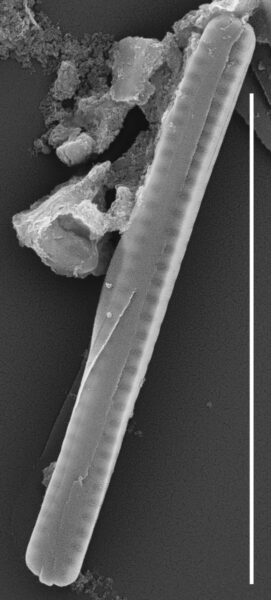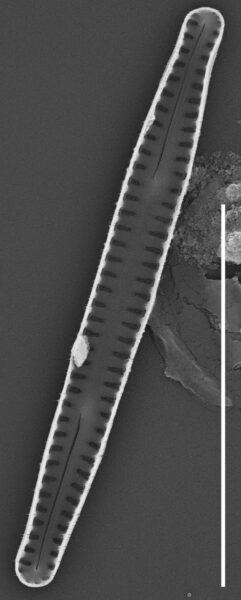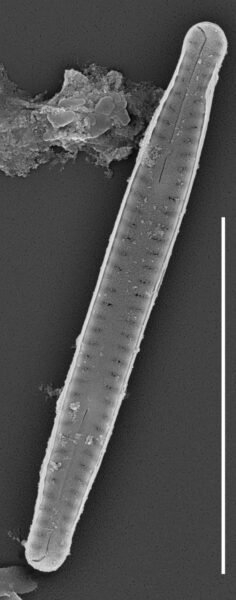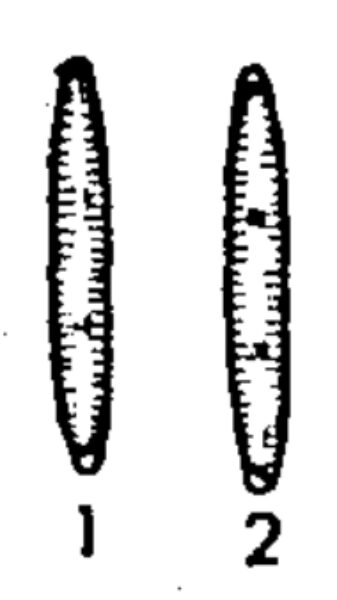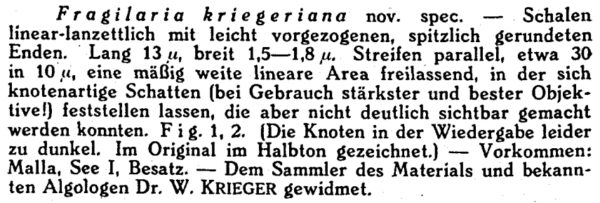Krasskella kriegeriana
-
Category
-
Length Range12.9-15.1 µm
-
Width Range1.2-1.6 µm
-
Striae in 10 µm25-26
-
SynonymsAmphipleura kriegeriana (Krasske) Hust. 1954
-
ContributorSarah Spaulding, Ian Bishop - Sep 2014
-
ReviewerMark Edlund - Oct 2014
Identification
Description
Valves are linear, with subcapitate to capitate apices. Valves are small and lightly silicified. The axial area is linear and narrow. The proximal raphe ends are distantly placed. In light microscopy, the proximal raphe ends are distinctly thickened. Striae are parallel in the center of the valve, and slightly convergent near the apices. Each stria is composed of a single elongate areola. In girdle view, frustules are narrow, nearly rectangular and the thickened proximal raphe ends are clearly visible.
This small, rare taxon has likely been overlooked or included with species of Achnanthidium, or perhaps Berkeleya rutilans in surveys of North American rivers.
Autecology
Krasskella kriegeriana has been found as rare taxon in Higgins Pond, Cape Cod, Massachusetts (Siver et al. 2005). It was also reported from South American glacial rivers (Rumrich et al. 2000), although the specimens do not conform to the type as described by Krasske (1943). In North America, K. kriegeriana is not uncommon in cold, nutrient poor rivers of the California Sierra Nevada Range. This taxon is also reported and illustrated from Michigan (Camburn and Charles 2000) and Fallu et al. (2000) from Quebec, reported as Amphipleura kriegeriana. Fallu et al. provides DOC optima (pg. 45). This taxon is included in the PIRLA Iconograph (Contrib 12, Pl 49, FIg 221) from Mud Pond, Maine with dimensions 12.5 µm in length, 1.5 µm in width and striae count of 28 in 10 µm.
-
Size Range, µm3
-
Motility
-
Attachment
-
Habitat
-
Colony
-
Occurrence
-
Waterbody
- Learn more about this
Citations & Links
Citations
Links
-
Index Nominum Algarum
Cite This Page
Spaulding, S., Bishop, I. (2014). Krasskella kriegeriana. In Diatoms of North America. Retrieved November 21, 2024, from https://diatoms.org/species/krasskella_kriegerana
Responses
The 15 response plots show an environmental variable (x axis) against the relative abundance (y axis) of Krasskella kriegeriana from all the stream reaches where it was present. Note that the relative abundance scale is the same on each plot. Explanation of each environmental variable and units are as follows:
ELEVATION = stream reach elevation (meters)
STRAHLER = distribution plot of the Strahler Stream Order
SLOPE = stream reach gradient (degrees)
W1_HALL = an index that is a measure of streamside (riparian) human activity that ranges from 0 - 10, with a value of 0 indicating of minimal disturbance to a value of 10 indicating severe disturbance.
PHSTVL = pH measured in a sealed syringe sample (pH units)
log_COND = log concentration of specific conductivity (µS/cm)
log_PTL = log concentration of total phosphorus (µg/L)
log_NO3 = log concentration of nitrate (µeq/L)
log_DOC = log concentration of dissolved organic carbon (mg/L)
log_SIO2 = log concentration of silicon (mg/L)
log_NA = log concentration of sodium (µeq/L)
log_HCO3 = log concentration of the bicarbonate ion (µeq/L)
EMBED = percent of the stream substrate that is embedded by sand and fine sediment
log_TURBIDITY = log of turbidity, a measure of cloudiness of water, in nephelometric turbidity units (NTU).
DISTOT = an index of total human disturbance in the watershed that ranges from 1 - 100, with a value of 0 indicating of minimal disturbance to a value of 100 indicating severe disturbance.

Krasskella kriegeriana
- Valves small
- Proximal raphe ends distant
- Stria composed of an elongate areola
Valves are small. The raphe is difficult to see in LM, but the proximal raphe ends are distinct thickenings placed at a distance from one another. Each stria is composed of a single elongate areola.
 Diatoms of North America
Diatoms of North America




